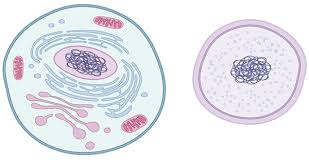Just as plants and animals are alive, so too are cells. Life, in fact, is the most basic property of cells, and cells are the smallest units to exhibit this property. Unlike the parts of a cell, which simply deteriorate if isolated, whole cells can be removed from a plant or animal and cultured in a laboratory where they will grow and reproduce for extended periods of time. If mistreated, they may die. Death can also be considered one of the most basic properties of life because only a living entity faces this prospect. Remarkably, cells within the body generally die “by their own hand”—the victims of an internal program that causes cells that are no longer needed or cells that pose a risk of becoming cancerous to eliminate themselves. all cells show
Cells Are Highly Complex and Organized:
There is a great deal of consistency at every level. Each type of cell has a consistent appearance when viewed under a high-powered electron microscope; that is, its organelles have a particular shape and location, from one individual of a species to another. Similarly, each type of organelle has a consistent composition of macromolecules, which are arranged in a predictable pattern.

All Cells Store Their Hereditary Information:
Organisms are built according to information encoded in a collection of genes, which are constructed of DNA. All living cells on the earth, without any known exception, store their hereditary information in the form of double-strand molecules of DNA. DNA guides growth, development and maintenance of tissues and organs of multicellular organisms. DNA instructions are passed from generation to generation (inherited) by the process of reproduction. Genes constitute the blueprints for constructing cellular structures, the directions for running cellular activities, and the program for making more of themselves. The molecular structure of genes allows for changes in genetic information (mutations) that lead to variation among individuals, which forms the basis of biological evolution.
Cells Are Capable of Producing More of Themselves:
Just as individual organisms are generated by reproduction, so too are individual cells. Cells reproduce by division, a process in which the contents of a “mother” cell are distributed into two “daughter” cells. Prior to division, the genetic material is duplicated, and each daughter cell receives a complete and equal share of genetic information.
Cells Acquire and Utilize Energy:
Energy All organisms require energy input to maintain the process of life. Living organisms must have capacity to obtain and convert energy from their surroundings to grow and maintain themselves. In Biology this phenomenon is known as metabolism. During metabolism the cells expend an enormous amount of energy simply breaking down and rebuilding the macromolecules and organelles of which they are made. This continual “turnover,” as it is called, maintains the integrity of cell components in the face of inevitable wear and tear and enables the cell to respond rapidly to changing conditions.
Cells Carry Out a Variety of Chemical Reactions:
Cells function like miniaturized chemical plants. The simplest bacterial cell is capable of hundreds of different chemical transformations. All these chemical changes take place in cells in presence of enzymes. Enzymes are the molecules those greatly increase the rate at which a chemical reaction occurs. The sum total of the chemical reactions in a cell represents that cell’s metabolism.
Cells Engage in Mechanical Activities:
Cells are sites of bustling activity. Materials are transported from place to place, molecules and structures are assembled and then rapidly disassembled, and, in many cases, the entire cell moves itself from one site to another. These types of activities involve dynamic, mechanical changes within cells, many of which are initiated by changes in the shape of “motor” proteins. Motor proteins are just one of many types of molecular “machines” employed by cells to carry out mechanical activities.
Cells Are Able to Respond to Stimuli:
Organisms constantly sense changes in their surroundings and make controlled response to those changes. They achieve sensing through their receptors and response accordingly. This communication between cells and environment called homeostasis. A single-celled protist, like amoeba for example, moves away from an object in its path or moves toward a source of nutrients. Most cells are covered with receptors that interact with substances in the environment in highly specific ways. Cells possess receptors to hormones, growth factors, and extracellular materials, as well as to substances on the surfaces of other cells. A cell’s receptors provide pathways through which external stimuli can evoke specific responses in target cells. Cells may respond to specific stimuli by altering their metabolic activities, moving from one place to another, or even committing suicide.
Cells Are Capable of Self-Regulation:
Cells are robust, because they are protected from dangerous fluctuations in composition and behavior. In case of any fluctuation, the feedback circuits are activated that help the cell to return to the appropriate state. In addition to requiring energy, maintaining a complex, ordered state requires constant regulation.
Cells Evolve:
It is presumed that cells evolved from some type of precellular life form, which in turn evolved from nonliving organic materials that were present in the primordial seas. The evolution of cells can be studied by examining organisms that are alive today. According to one of the tenets of modern biology, all living organisms have evolved from a single, common ancestral cell that lived more than three billion years ago. Evolution is not simply an event of the past, but an ongoing process that continues to modify the properties of cells that will be present in organisms that have yet to appear.
5 replies on “Basic Characteristics of Cell”
Very goood
It so good explanation
Quite good explanations of the main functions. I loved it👍
Super
Fantastic
Fantabulous
Extraordinary
Outstanding
Unbelievable
Unbeatable
Splendid
Marvelous
Phenomenal
Historic
Jay mata di
Let’s rock
Very impressive.. Such a good explanation.. Thanks a lot